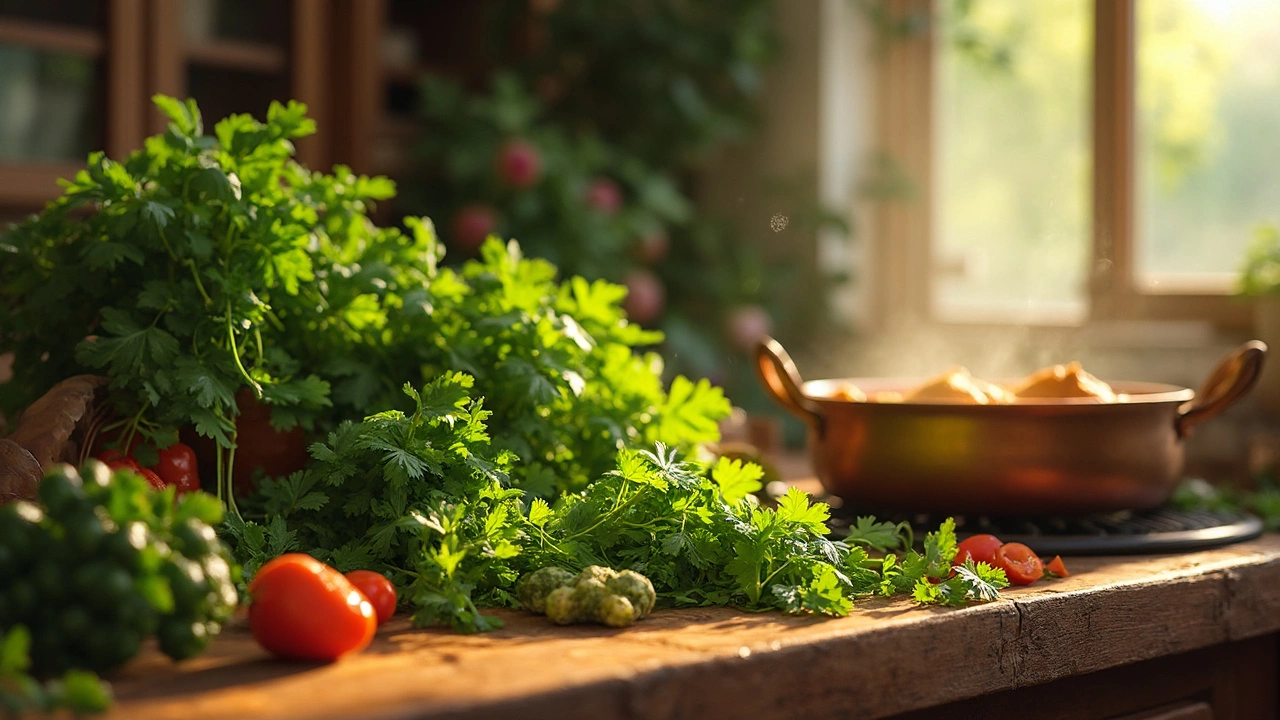Top Herbs for Elevating Your Chicken Curry
 Feb, 5 2025
Feb, 5 2025
When you're cooking up a chicken curry, choosing the right herbs could make all the difference. Think of herbs as your secret weapon in unlocking layers of flavors you didn’t even know existed in your dish. But where to begin? Well, let's start by talking about cilantro, one of the most popular herbs for curry. Offering a fresh, tangy kick, cilantro is perfect for sprinkle-on-top duty just before serving.
Don’t forget about mint. Not just for mojitos or tea, mint gives your curry a cool and refreshing lift. Plus, it pairs remarkably well with spicy ingredients, balancing out heat with its soothing touch. Throw in a few leaves next time and notice the difference in your palate!
If you’re after something more aromatic, look no further than basil or lemon balm. Both herbs add a sweet yet peppery scent that mingles wonderfully with the other spices typically found in curry. Don’t be afraid to experiment! Toss in some freshly chopped leaves towards the end for the maximum aroma.
- Must-Try Herbs for Chicken Curry
- Adding Freshness and Aroma
- Balancing Flavors Perfectly
- Spicing it Up a Notch
- Tips for Herb Usage
Must-Try Herbs for Chicken Curry
Choosing the right herbs can take your chicken curry from average to absolutely mind-blowing. It's all about knowing what each herb brings to the table and how it can enhance the overall flavor profile of your curry.
Cilantro
One of the go-to herbs for many curry enthusiasts is cilantro. Its fresh and zesty taste not only brightens the dish but also complements the richness of curry perfectly. A sprinkle of freshly chopped cilantro right before serving can give a delightful twist. As chef Anjum Anand once noted in an interview,
"Cilantro lends a remarkable freshness to curries, balancing the spices beautifully."
Basil
If you want to add an aromatic touch, then fresh basil is your guy. Known for its sweet yet spicy scent, basil enhances the flavors of your curry, adding a subtle peppery note. A handful of basil leaves just before serving can really lift your dish.
Mint
When it comes to cooling down a spicy curry, nothing beats mint. This herb adds a refreshing element, making the curry experience even more enjoyable. Toss a few mint leaves in right at the end, and watch it work its magic.
Lemongrass
Often used in Thai curries, lemongrass offers a citrusy touch that can transform your chicken curry. It pairs beautifully with coconut milk-based recipes, giving a light and fragrant finish. Remember to bruise the stalks slightly to release the oils before tossing them into the pot.
Fenugreek Leaves
For something a bit different, try fenugreek leaves, also known as methi. These leaves introduce a nutty and bittersweet flavor, perfect for more robust curries. A small amount goes a long way, so sprinkle judiciously.
| Herb | Flavor Profile | Best Used |
|---|---|---|
| Cilantro | Fresh, zesty | As a topping |
| Basil | Sweet, peppery | Towards the end |
| Mint | Refreshing, cool | As a garnish |
| Lemongrass | Citrusy, fragrant | Infused in the curry |
| Fenugreek | Nutty, bittersweet | Sprinkled sparingly |
Using the right mix of herbs can completely transform your chicken curry. It's a small step that makes a big difference, and it's definitely worth experimenting with these suggestions to find what suits your palate best.
Adding Freshness and Aroma
Want your chicken curry to stand out with a fresh kick? Including the right herbs can completely refresh and brighten the flavors of your dish. Cilantro is usually the go-to choice due to its unique citrusy flavor that complements the complexity of curry spices. Just chop some fresh cilantro and sprinkle it on top before serving; it adds both zest and an inviting fragrance.
Another fantastic herb is mint. This one's a game changer if you're seeking a cooling effect to balance out any spicy heat. You can toss in whole or chopped mint leaves—either way, it's sure to give a refreshing lift. Plus, mint is incredibly resilient, making it super easy to grow in your own kitchen garden!
Embracing Aromatic Herbs
For those craving something more aromatic, give basil a go. It might sound strange since basil is more common in Italian dishes, but it works wonders in curry too. Thai basil, in particular, has a lovely aniseed flavor that gels nicely with coconut milk-based curries. Drop in a handful towards the end of cooking for an aromatic boost.
The Lesser-known Herb: Lemon Balm
Consider trying lemon balm when you're in the mood to experiment. Its lemony scent and mild flavor nicely complement the rich spices of chicken curry. Although not as mainstream, lemon balm offers a nuanced citrus touch that's quite refreshing. A little goes a long way with this herb, so you don't need much to make an impact.
Adding freshness and aroma isn't just about taste; it's about enhancing the overall dining experience. With just the right herbs, you can take your chicken curry to astounding new heights—and maybe even impress a few guests along the way!

Balancing Flavors Perfectly
When it comes to making a delicious chicken curry, balancing the flavors is crucial. Think of your curry as a symphony where every player has to hit the right note. So, how do you make sure your herbs are hitting those high notes?
Understanding Herb Profiles
Each herb brings something unique to the table. Cilantro, for instance, is light and citrusy, while basil provides a sweet and spicy punch. Knowing what each herb does helps you mix and match effectively. Try pairing cilantro with basil for a balanced blend, bringing brightness and depth together.
A Dash of Sweetness
If your curry is too spicy, consider adding a little sweetness. Basil and lemon balm can work wonders here. Adding a few chopped leaves in your curry can mellow out excessive heat while enhancing the overall flavor. Imagine the subtle sweetness balancing the recipe rather than letting the spice overpower your senses.
The Secret of Timing
When you add your herbs can also change the game. Toss them in too early, and you lose their fresh impact. For chicken curry, it's best to add herbs like cilantro, mint, and basil toward the end of cooking. This maintains their vibrant flavor and keeps your dish from tasting one-dimensional.
Practical Tips for Balance
- Taste as you go: Don’t wait until the end to taste your curry. Add herbs incrementally and adjust as needed.
- Use fresh herbs: Fresh herbs have a more lively taste than dried ones. Whenever possible, use them fresh for that punchy flavor.
- Pairing with acidity: A splash of lime juice can complement herbs and round up the taste, making it a must-try at the end of your chicken curry journey.
Remember, balancing flavors in curry is an art form that gets better with practice. Over time, you'll find your perfect harmony of herbs that suits your taste just right!
| Common Herb Pairings | Flavor Impact |
|---|---|
| Cilantro & Basil | Bright & Sweet |
| Mint & Lemon Balm | Refreshing & Mildly Sweet |
| Cilantro & Mint | Tangy & Cooling |
Spicing it Up a Notch
Alright, if you're looking to bring out the fiery, bold side of your chicken curry, then spicing it up a notch is where you'll want to focus. Sure, you've already included the regular spices, but there's always room to amp up the flavor profile.
Adding a Dash of Fire
First on the list should be curry leaves. They’re not just for looks; these little green powerhouses pack a punch of spicy flavor. Sauté them in hot oil before adding them to your curry to release their earthy aroma and spicy essence.
For the Adventurous Souls
If you want to take it even further, introduce a touch of crushed red pepper flakes or even fresh green chilies. These ingredients heighten the heat and add complexity to the flavor without overwhelming the dish's balance. Just remember, a little goes a long way!
The Secret Ingredient
Here's a trick not everyone knows: incorporate a bay leaf or two while the curry simmers. It subtly enhances the spices and adds depth without making things overly intense.
| Herb | Effect |
|---|---|
| Curry Leaves | Boost spicy flavors |
| Red Pepper Flakes | Introduce heat |
| Bay Leaf | Enhance depth |
Finally, finish off by garnishing with parsley or a squeeze of lime for contrast. Not only do these additions spice it up, but they also make your curry more vibrant and flavorful.

Tips for Herb Usage
Using herbs in chicken curry isn't rocket science, but there are a few things you should keep in mind. First off, herbs are best when fresh. Dried versions are useful in a pinch, but nothing beats that vibrant burst you get from fresh herbs. If you can, aim for fresh cilantro, mint, or basil from your local market or better yet, your own kitchen garden. These herbs are prime options for elevating your chicken curry.
The Timing Trick
Timing is essential. Generally, it's best to add fresh herbs right towards the end of cooking. This trick locks in their flavors and ensures they maintain their color and aroma. Using them for garnish? Simply chop and sprinkle them over your finished curry for that Instagram-worthy look and taste.
Chop Choppy
When it comes to chopping, don't overdo it. Over-chopping bruises the herbs, causing them to lose essential oils. A rough chop or a few snips with kitchen scissors usually does the trick. Keep it simple.
Quantity Matters
There's a saying: Too much of anything is good for nothing. This couldn't be truer than with herbs. A handful of herbs for a large curry pot is about right. For herbs like mint, start with half the amount first, since it can be quite strong.
Balance Basics
- Pairing mint with chilis tamps down the spice while adding freshness.
- Cilantro goes beautifully with onion toppings, adding a zesty edge.
- Basil and curry leaves add a warm, deep aroma. Use sparingly.
Remember, taste as you go. That’s the surest way to get the perfect balance. Just like salt, you can always add more herbs if necessary but taking them out is a different story.
